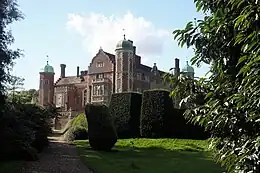Rosamond Harding
Rosamond Harding (6 April 1898 – 6 May 1982)[1][2] was an English music scholar, writer, organologist, and instrument collector.[1][3][4] Her book The Piano-forte: its History Traced to the Great Exhibition of 1851 became the standard work on the subject.[5]
Dr Rosamond Harding | |
|---|---|
| Born | Rosamond Evelyn Harding 6 April 1898 Doddington, Cambridgeshire, England, UK |
| Died | 6 May 1982 (aged 84) Southwold, Suffolk, England, UK |
| Resting place | St Mary Magdalene Churchyard, Madingley, Cambridgeshire |
| Education | Newnham College, Cambridge |
| Occupation(s) | Music scholar, writer |
| Notable work | The Piano-forte: its History Traced to the Great Exhibition of 1851 (1933); An Anatomy of Inspiration (1940) |
Life

Rosamond Evelyn Mary Harding[4] was born in Doddington, Cambridgeshire, the first child of Ambrose and Adela Harding (née Ethel Adela Hirst).[1][3] The family were wealthy and lived comfortably.[3] When Rosamund was one year old, the family moved to Histon Manor House, in Histon, north of Cambridge.[3] She was educated at boarding schools and at home, where her father also taught her skills in drawing and illustration.[3] During the First World War, Harding worked at a Chivers and Sons jam factory, and in 1922 began studying music at Newnham College, Cambridge.[3][4] Disappointed with her grades, she dropped out after her first year.[3]
In 1927, Harding's father inherited Madingley Hall, which became the family home.[3] There, Harding began research for a PhD, under the tutelage of Edward Joseph Dent.[3] Her completed thesis was titled The Piano-forte - its history traced to the Great Industrial Exhibition, 1851.[3] This was subsequently published, but sold a disappointing 93 copies in its first four years.[3] Harding also published the first modern edition of Ludovico Giustini's 1732 work Twelve Sonatas for Pianoforte, the oldest music published specifically for the pianoforte.[3]
During the Second World War, in spite of being a qualified pilot, Harding - like many other women - was rejected for wartime service. Instead, she volunteered as an Air Raid Warden.[3]
Both of Harding's parents died in 1942, during which year she held a research fellowship at Newnham College, and was appointed its Director of Studies in Music.[4] In 1948, the trustees of Madingley Hall sold it to the University of Cambridge, requiring Harding to move. She lived in Icomb, Gloucestershire until 1954, then lived in a series of rentals in Cambridgeshire until settling in Southwold.[3]
Rosamond Harding died in Southwold, Suffolk on 6 May 1982.[1][5] She is buried in St Mary Magdalene Churchyard, Madingley.[1]
Works
Of The Piano-forte: its History Traced to the Great Exhibition of 1851, Michael Cole wrote:
Anyone who reads Rosamond Harding's history of the pianoforte must be profoundly impressed. Her readiness to explore and report the often bewildering byways of early piano actions; the precision of her technical drawings (which she laboriously executed herself in pen and ink); and the copious appendices with their heavy burden of reference data - such features tell us very quickly that we are engaging with an author with serious aims and high intellectual attainments.[1]
Cole notes that the book remained "unquestionably the standard work on technical development of the pianoforte for at least half a century", and "is still recommended reading for anyone embarking on a piano technician's course... [remaining] a familiar reference work for curators and collectors of old keyboard instruments".[1]
Although sales of her history of the pianoforte were disappointing during her lifetime, Harding's An Anatomy of Inspiration proved very popular, running through multiple editions.[3] Cole calls it "in many ways her most readable and thought provoking book".[1]
According to Maria Popova, in this book Harding set out "to reverse-engineer the mechanisms of creativity through the direct experiences of famous creators across art, science, and literature".[6] Popova writes that:
One particularly interesting notion Harding puts forth is that of “fringe-ideas” — ideas on the periphery of the thinker’s particular inquiry, but resonant in tone and thus able to enhance and flow into the creative process.[6]
She called Harding's book "an invaluable lens on the nooks and crannies of the creative process."[6]
On her death, The Times wrote of Harding that "her substantial and pioneering contribution to the detailed study of the rise of the pianoforte... remains her monument".[2]
Bibliography
- A History of the Piano-Forte. University Press, Cambridge, 1933
- Twelve Piano-Forte Sonatas of L. Giustini di Pistoia (1732). Edited in facsimile with Preface and Notes. University Press, Cambridge, 1933
- Towards a Law of Creative Thought. Kegan Paul, Trench, Trubner & Co., London, 1936
- Origins of Musical Time and Expression. Oxford University Press, London, 1938
- An Anatomy of Inspiration. W. Heffer & Sons Ltd., Cambridge, 1940
- A Thematic Catalogue of the Works of Matthew Locke with a Calendar of the Main Events of his Life. Oxford, 1971
References
- Cole, Michael (2007). "Rosamond Harding: Author and Musicologist". The Galpin Society Journal. Galpin Society. 60: 71–84. ISSN 0072-0127 – via JSTOR.
- "Dr Rosamond Harding". The Times. 12 May 1982. p. 12.
- Cole, Michael. "Rosamond Harding". Square Pianos. Retrieved 30 April 2023.
- Acker, Anne Beetem (8 December 2014). "Harding, Rosamond Evelyn Mary". Grove Music Online. Oxford University Press. doi:10.1093/omo/9781561592630.013.3000000084. Retrieved 30 April 2023.
- "Rosamond Harding". The Musical Times. 124 (1681): 186–186. March 1983. ISSN 0027-4666 – via JSTOR.
- Popova, Maria (9 July 2012). "An Anatomy of Inspiration: A 1942 Guide to How Creativity Works". The Marginalian. Retrieved 30 April 2023.
External links
- Rosamond Harding at Find a Grave
- An Anatomy of Inspiration by Rosamond Harding at the Internet Archive